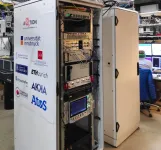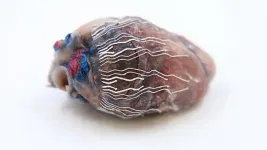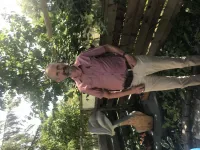Compact quantum computer for server centers
Researchers build smallest quantum computer yet based on industry standards
2021-06-18
(Press-News.org) Over the past three decades, fundamental groundwork for building quantum computers has been pioneered at the University of Innsbruck, Austria. As part of the EU Flagship Quantum Technologies, researchers at the Department of Experimental Physics in Innsbruck have now built a demonstrator for a compact ion trap quantum computer. "Our quantum computing experiments usually fill 30- to 50-square-meter laboratories," says Thomas Monz of the University of Innsbruck. "We were now looking to fit the technologies developed here in Innsbruck into the smallest possible space while meeting standards commonly used in industry." The new device aims to show that quantum computers will soon be ready for use in data centers. "We were able to show that compactness does not have to come at the expense of functionality," adds Christian Marciniak from the Innsbruck team.
The individual building blocks of the world's first compact quantum computer had to be significantly reduced in size. For example, the centerpiece of the quantum computer, the ion trap installed in a vacuum chamber, takes up only a fraction of the space previously required. It was provided to the researchers by Alpine Quantum Technologies (AQT), a spin-off of the University of Innsbruck and the Austrian Academy of Sciences which aims to build a commercial quantum computer. Other components were contributed by the Fraunhofer Institute for Applied Optics and Precision Engineering in Jena and laser specialist TOPTICA Photonics in Munich, Germany.
Up to 50 quantum bits
The compact quantum computer can be operated autonomously and will soon be programmable online. A particular challenge was to ensure the stability of the quantum computer. Quantum devices are very sensitive and in the laboratory they are protected from external disturbances with the help of elaborate measures. Amazingly, the Innsbruck team succeeded in applying this quality standard to the compact device as well, thus ensuring safe and uninterrupted operation.
In addition to stability, a decisive factor for the industrial use of a quantum computer is the number of available quantum bits. Thus, in its recent funding campaign, the German government has set the goal of initially building demonstration quantum computers that have 24 fully functional qubits. The Innsbruck quantum physicists have already achieved this goal. They were able to individually control and successfully entangle up to 24 ions with the new device. "By next year, we want to be able to provide a device with up to 50 individually controllable quantum bits," says Thomas Monz, already looking to the future.
The project is financially supported by the Austrian Science Fund FWF, the Research Funding Agency FFG, the European Union, and the Federation of Austrian Industries Tyrol, among others.
INFORMATION:
Publication: Compact Ion-Trap Quantum Computing Demonstrator. I. Pogorelov, T. Feldker, Ch. D. Marciniak, L. Postler, G. Jacob, O. Krieglsteiner, V. Podlesnic, M. Meth, V. Negnevitsky, M. Stadler, B. Höfer, C. Wächter, K. Lakhmanskiy, R. Blatt, P. Schindler, and T. Monz
PRX Quantum 2, 020343 - Published 17 June 2021
https://doi.org/10.1103/PRXQuantum.2.020343
[Attachments] See images for this press release:

ELSE PRESS RELEASES FROM THIS DATE:
2021-06-18
The glaciers of Nanga Parbat - one of the highest mountains in the world - have been shrinking slightly but continually since the 1930s. This loss in surface area is evidenced by a long-term study conducted by researchers from the South Asia Institute of Heidelberg University. The geographers combined historical photographs, surveys, and topographical maps with current data, which allowed them to show glacial changes for this massif in the north-western Himalaya as far back as the mid-1800s.
Detailed long-term glacier studies that extend the observation period to the time before the ubiquitous ...
2021-06-18
How much do traditional practices contribute to the protection of local biodiversity? Why and how are sacred groves locally valued and protected, and how can this be promoted and harnessed for environmental protection? Working together with the University of Kurdistan, researchers of the University of Göttingen and the University of Kassel have examined the backgrounds of this form of local environmental protection in Baneh County, Iran.
"Around the world, local communities are voluntarily protecting certain parts of their surroundings due to religious ...
2021-06-18
Researchers at the University of Texas Medical Branch have observed that SARS-CoV-2, the virus that causes COVID-19, can infect the testes of infected hamsters. The findings, published in the journal Microorganisms, could help explain symptoms some men with COVID-19 have reported and have important implications for men's health.
As the pandemic goes on, clinicians continue to report their findings that COVID-19 affects more than just the lungs. Some patients have reported testicular pain and some reports have shown decreases in testosterone, a key hormone produced in the ...
2021-06-18
Below please find a summary for a new article that will be published today in Annals of Internal Medicine. The summary is not intended to substitute for the full article as a source of information. This information is under strict embargo and by taking it into possession, media representatives are committing to the terms of the embargo not only on their own behalf, but also on behalf of the organization they represent.
FDA advisory panelist outlines numerous issues with aducanumab's accelerated approval for Alzheimer's disease
Abstract: https://www.acpjournals.org/doi/10.7326/M21-2603
URL ...
2021-06-18
WEST LAFAYETTE, Ind. – Surgeons may soon be able to localize critical regions in tissues and organs during a surgical operation thanks to a new, patent-pending Purdue University biosensor that can be printed in 3D using an automated printing system.
Chi Hwan Lee created the biosensor, which allows for simultaneous recording and imaging of tissues and organs during a surgical operation. Lee is the Leslie A. Geddes Assistant Professor of Biomedical Engineering in the Weldon School of Biomedical Engineering and assistant professor of mechanical engineering. Lee also has a courtesy appointment in materials engineering.
"Simultaneous recording and imaging could be useful during heart surgery in localizing critical regions and guiding ...
2021-06-18
In the realm of social media, anti-science views about COVID-19 align so closely with political ideology -- especially among conservatives -- that its predictability offers a strategy to help protect public health, a new USC study shows.
Resistance to science, including the efficacy of masks and vaccines, poses a challenge to conquering the coronavirus crisis. The goal of achieving herd immunity won't happen until society achieves consensus about science-based solutions.
The USC study's machine-learning assisted analysis of social media communications offers policymakers and public health officials new tools to anticipate shifts in attitudes ...
2021-06-18
A rare parasitic infection imported from Europe continues to take root in Alberta, Canada. The province is now the North American hotspot for human alveolar echinococcosis (AE), which takes the form of a growth in the liver, causing serious and potentially deadly health complications.
A END ...
2021-06-18
Only 2% of vehicles are electrified to date, but that is projected to reach 30% in 2030. A key toward improving the commercialization of electric vehicles (EVs) is to heighten their gravimetric energy density - measured in watt hours per kilogram - using safer, easily recyclable materials that are abundant. Lithium-metal in anodes are considered the "holy grail" for improving energy density in EV batteries compared to incumbent options like graphite at 240 Wh/kg in the race to reach more competitive energy density at 500 Wh/kg.
Yan Yao, Cullen Professor of electrical ...
2021-06-18
MIAMI--In a new analysis on managed retreat--the climate adaptation response of moving people and property out of harm's way--researchers explore what it would take for managed retreat to be supportive of people and their priorities. A key starting point is considering retreat alongside other responses like coastal armoring and not just as an option of last resort.
In a new paper in the journal Science, University of Miami (UM) Rosenstiel School of Marine and Atmospheric Science researcher Katharine Mach argues that managed retreat should be viewed as a proactive option that can support communities and livelihoods in the face of climate change.
"Managed retreat ...
2021-06-18
The surface of a material often has properties that are very different from the properties within the material. For example, a non-conducting crystal, which actually exhibits no magnetism, can show magnetisation restricted to its surface because of the way the atoms are arranged there. These distinct properties at interfaces and surfaces of materials often play a key role in the development of new functional components such as optoelectronic chips or sensors and are therefore subject to extensive research. An international research team from the University of Göttingen, the Max Planck Institute for Biophysical Chemistry Göttingen and the National Research Council Canada has now succeeded in investigating the surfaces of transparent crystals using ...
LAST 30 PRESS RELEASES:
[Press-News.org] Compact quantum computer for server centers
Researchers build smallest quantum computer yet based on industry standards






